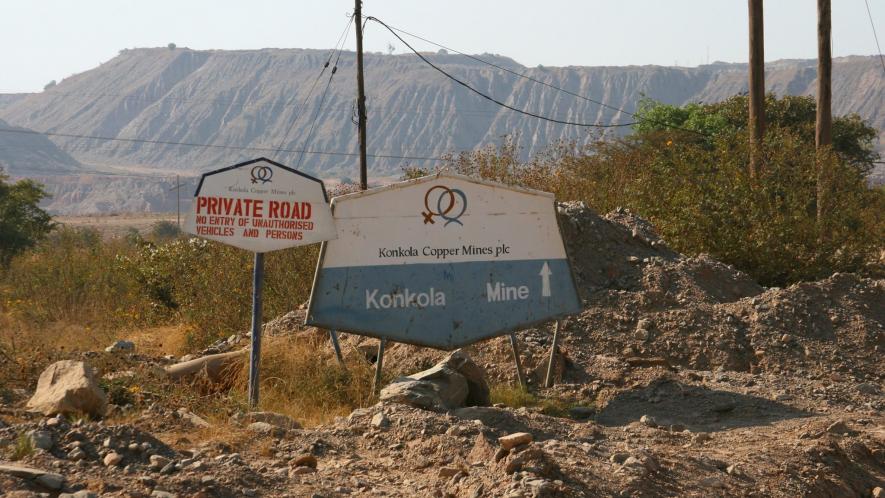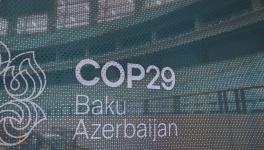Neocolonial Debt, Extractivism, and Roots of Zambia’s Economic Crisis

Wikimedia Commons
A second of Zambia’s major copper mines is set to come under private control as Lusaka reached an agreement with UAE-based International Resource Holdings (IRH) this month. The corporation will acquire a 51% stake in the Mopani copper mine, which Zambia’s state-owned ZCCM-IH had bought from Swiss mining giant Glencore and Canada’s First Quantum Minerals (FQM) in 2021.
The 2021 deal, which was valued at USD 1.5 billion, was financed through a loan, under the terms of which Zambia would pay Glencore 3% of Mopani’s gross revenue between 2021 and 2023, following which the share would range from 10 up to 17.5%.
According to Zambia’s finance minister, Situmbeko Musokotwane, a total of USD 620 million of IRH’s investment will go towards expanding Mopani. Meanwhile, USD 400 million will go towards repaying the loan under the Glencore agreement.
Zambia is the second largest producer of copper on the African continent. Copper constitutes about 13% of Zambia’s GDP and 70% of its exports, as such serving as a key source of foreign exchange.
The metal is essential in the development of electric vehicles and renewable energy. US-based venture capitalists, like KoBold Metals, and their billionaire backers, including Microsoft founder Bill Gates and Amazon founder Jeff Bezos, have as such been rushing to maximize their share in it.
The acquisition of the Mopani mine has also been welcomed in the western mainstream and credit ratings agencies as a way for Zambia to recover its economy and deal with a major debt crisis.
Foreign control over key resources
The agreement with IRH follows just a few months after Vedanta Resources regained control of the Konkola Copper Mines (KCM). The Zambian government had seized control of the operation from the Indian-origin mining giant in 2019. What followed was a legal dispute, with the Zambian government accusing Vedanta of failing to uphold certain financial and investment-related obligations, including commitments for expansion as well as not paying required taxes.
As part of an agreement reached with the administration of incumbent president Hakainde Hichilema, Vedanta has made new commitments, including USD 250 million in payments to KCM’s local creditor and a previously unfulfilled promise to invest USD 1 billion over five years for expansion.
After failing to pay workers ahead of KCM’s takeover by the government in 2019, Vedanta has now also agreed to implement a 20% pay increase and give a one-time payment of ZMW 2,500 (USD 119.9) to all workers.
While the agreement with Vedanta has been welcomed by western-based news organizations and credit agencies for its potential to “revive” Zambia’s copper sector, progressive forces in the country have criticized the takeover, drawing on Vedanta’s track record over the 15 years that it controlled a majority stake in KCM.
“[President Haikainde Hichilema’s] actions were particularly painful given that KCM retrenched thousands of workers, withdrew ZCCM social benefits for workers, introduced precarious subcontracting, refused to pay taxes and irresponsibly polluted the rivers on which the poor people of Chingola depend for drinking water and agriculture,” the Socialist Party (SP) of Zambia said in a statement.
Vedanta settled the claims brought by over 2,500 villagers from Chingola in 2021, without admitting liability.
In 2013, following KCM’s decision to retrench over 1,500 workers, the government of Zambia appointed an audit committee to look into the company. The investigation, whose conclusion was presented to the Zambian parliament in 2019, found that as of September 30, 2013, KCM’s total liability stood at USD 1.5 billion against the value of current assets (at the time) at USD 123 million. By the time the liquidator was appointed in 2019, KCM’s debt stood at USD 2.5 billion.
Not only that, Vedanta had also failed to comply with its commitment to put USD 397 million in KCM as foreign direct investment (FDI).
“This is the same company that bragged about making an easy profit of USD 500 million each year from KCM, the mine purchased for a mere US 25 million [against an asking price of USD 400 million, Vedanta Resources Founder Anil Agarwal had claimed in a video circulated in 2014] while declaring losses every year, and refusing to pay taxes,” the SP added.
“What is happening in Zambia is not unique. There is a lot of exploitation, tax-dodging, and lack of transparency when it comes to multinational corporations running mining operations in the Global South,” Dr. Grieve Chelwa, an Associate Professor of Political Economy at the Africa Institute, told Peoples Dispatch.
After the takeover in 2019, “Zambia was trying to find an investor for KCM, or to even run the mine itself, however there was a change of government [in August 2021]. We moved from what could be called a left of center party, or a party with leftist inspirations, to a new neoliberal regime and Vedanta is back, making the same type of promises it has made since it first appeared in the copper sector in 2005.”
Delays in debt restructuring
The agreements for KCM and Mopani have been secured against the backdrop of an economic crisis characterized by the depreciation of the value of Zambia’s Kwacha, rising costs of living, and a major debt crisis. At the end of 2022, Zambia’s external debt stood at USD 18.6 billion.
By the onset of the COVID-19 pandemic, Zambia’s debt had soared to 118% of its GDP. In November 2020, Zambia became the first African country to default on its debt payment.
In February 2021, the Zambian government, then under president Edward Lungu, formally applied for a debt restructuring under the Common Framework initiative of the G20 countries, a mechanism that was supposed to help countries by engaging both country-to-country and private creditors.
The involvement of private creditors in the Common Framework was important given that western corporations had come to play a major role in the debts of countries like Zambia, where US-based asset manager BlackRock was the largest holder of its bonds at USD 220 million. According to Debt Justice, 45% of Zambia’s external debt payments between 2022 and 2028 were to western private lenders.
Read more: Who is responsible for Ghana’s debt crisis?
Finally in June 2023, Zambia secured an agreement with its official creditors to restructure USD 6.3 billion of its debt under the Common Framework, which was formalized through a Memorandum of Understanding in October. While the exact terms of the deal were unknown, analysis by the Zambia Civil Society Debt Alliance and Debt Justice showed that it would reduce the value of debt payments by 40%.
However, while it offered substantial payment cuts in the 2020s and early 2030s, high debt payments would return by the end of the next decade. Crucially, the deal contained a clause under which if Zambia’s “debt carrying capacity” was assessed to have improved by even a “tiny amount” by the IMF and the World Bank, it would trigger an increase in payments to its bilateral creditors.
This would in turn effectively reduce the amount of debt relief to just 18%. Meanwhile, if Zambia were to undergo further economic shocks and if its revenue were to decline— a situation that is highly possible given the volatility of commodity prices like copper— there is no mechanism to reduce its debt payments.
“It was important for the west that the Common Framework works— not for the countries of the Global South, but to demonstrate that the existing multilateral system, which remains under western domination, still works,” Chelwa said. “It was not a victory for Zambians, but for this system, especially given that China was a big part of this agreement”. Out of the USD 6.3 billion in debt that was earmarked for restructuring, USD 4.2 billion was owed to Chinese entities.
The US has made a big deal of emphasizing China’s role in Zambia’s debt crisis, repeatedly invoking baseless accusations of “China’s debt trap diplomacy.”
Towards the end of 2023, the restructuring process was hit by delays, primarily due to disagreements on the terms offered to Zambia’s official creditors versus private lenders. Beijing has repeatedly called on private lenders to share a “fair burden” in the debt restructuring, in accordance with the Common Framework which calls on private creditors to offer “at least as favorable” terms as government lenders.
While official creditors had initially agreed to a “haircut” (a reduced payment) of about 45%, the Zambian government reportedly promised private lenders much favorable terms– a reduction of only 27%, with a potential to be reduced to just 3%.
With the restructuring now in flux, the situation in Zambia raises deeper questions, of the recurring crises of debt and the “paradoxes” of mineral wealth and impoverishment which are all too familiar to the Global South— neither of which should be simplistically explained away as failures of governance or state incapacity.
Resource sovereignty, economic sovereignty
“We should be using copper as a vehicle to supercharge our aspirations to industrialize, and therefore to develop. To be able to do that, we need to have control of our copper sector, to make sure that foreign exchange earnings are repatriated to Zambia, that proper amounts of tax are levied and that taxes are actually being paid,” Chelwa said.
“We have had a largely foreign-owned copper mining sector which many would argue, and it is even factual, has very little to deliver in terms of development. Instead, it operates as an enclave, divorced from the rest of Zambian economic life.”
Speaking to Peoples Dispatch, Cosmas Musumali, an economist and the General Secretary of the Socialist Party (SP) of Zambia, added, “What we have in Zambia is a colonial pattern of mining. These corporations have found ways of not declaring profits and exaggerating costs of production.”
“Soon after independence, there was an attempt under president Kenneth Kaunda to nationalize the mining sector, 51% ownership was secured. However, this has since been surrendered over the years. Now, if we are not participating in the sector in terms of ownership, we have to participate in terms of getting royalties and taxes. Rather than dealing with these issues aggressively, we have a government that is playing to the tune of multinationals.”
This is compounded by the “advice” given by institutions like the IMF, which push governments including in Lusaka to implement austerity measures instead of properly taxing corporations in the mining sector. In 2022, Zambia reached a USD 1.3 billion bailout agreement with the IMF, with payouts conditional on the restructuring of its debt.
Also read: Zambia’s debt crisis a warning for what looms ahead for Global South
Moreover, whatever foreign exchange Zambia is earning through its mining sector, only a fraction finds its way back into the country, Musumali explained. Switzerland has been one of the main destinations of copper exported from Zambia. However, the exports of copper from Zambia to Switzerland far exceeds the reported imports of Switzerland from Zambia.
In fact, much of Zambian copper is not actually shipped to Switzerland. Rather, it is sold by traders in transit while still being recorded as being exported to Switzerland.
“For instance, if Zambia earns about USD 4 billion annually from copper mining, this money is not credited to the central bank account. Rather, a lot of the mining revenue ends up in a Swiss account. Switzerland is where the financial transactions are taking place and it is only a portion of Zambian input that draws forex into the country. Just enough dollars are brought in to pay for Zambian labor and contractors. This is at times less than 20% of the total production cost.”
Musumali added, “On paper it will show that Zambia has earned USD 4 billion, but that is not reflected in the central bank’s account. Insufficient forex means that we are unable to stabilize our currency or to make payments. We have to resort to borrowing from the IMF, which imposes conditionalities…it is a vicious cycle of poverty, underdevelopment and exploitation.”
What would it look like, then, for Zambia to be able to take control of its copper sector?
“There is often a racist colonial trope of incapacity that is deployed to say that a country is not capable of taking charge of its affairs. We might not have enough capital to pump into the copper industry but that does not necessarily imply foreign direct investment, it could very well mean that the Zambian government looks for capital, including by partnering with other governments in the Global South,” Chelwa said.
Equally important is that processing and manufacturing, where profits can be made, be done in Zambia. “A lot of our copper in Zambia is crudely refined. We have refineries here that process a good proportion of copper that is exported,” Musumali said. “Moreover, the few refineries that we have that have better capacity to extract copper do not do it for the ore that is mined in Zambia, so that is also a huge loss”.
“The logical thing to do is to set up factories in the country that depend on copper for a big portion of their input so we are mining, processing, and manufacturing goods and exporting finished products— this way our forex earnings will effectively triple. Not to mention the fact that we will be creating jobs at each stage… But this is not in the interest of imperialism and the multinational corporations.”
Musumali added, “People see their poverty, they are becoming conscious that their resources are not being used to develop and improve their lives. Because of this contradiction between the MNCs and the ruling elite on the one hand and the masses on the other, economies that are similarly dependent on minerals will always be time bombs.”
“The only way out is a transformation, for us to reverse the colonial pattern of extraction, for the Zambian people to own what is theirs.”
Get the latest reports & analysis with people's perspective on Protests, movements & deep analytical videos, discussions of the current affairs in your Telegram app. Subscribe to NewsClick's Telegram channel & get Real-Time updates on stories, as they get published on our website.




















